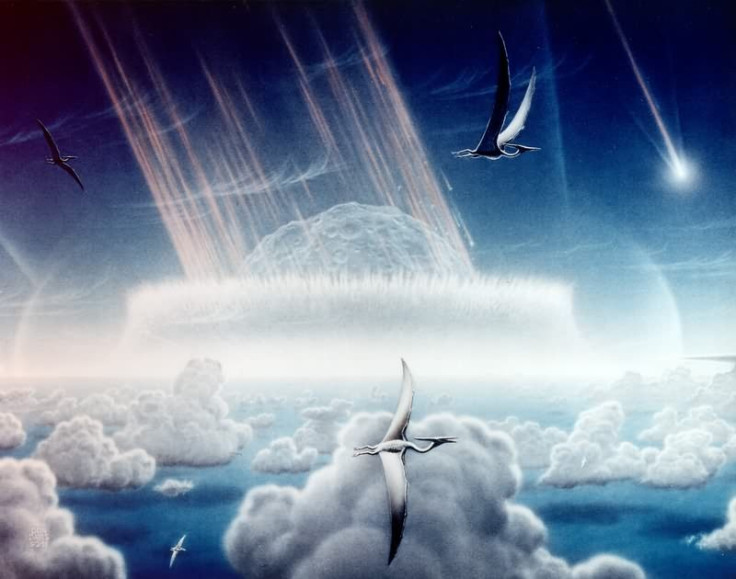Dinosaur-Killing Asteroid Triggered 'Monstrous' Global Tsunami, Researchers Find [Video]
KEY POINTS
- The tsunami had 30,000 more energy than the 2004 Indian Ocean tsunami
- It disrupted sediments in basins halfway across the globe
- This is said to be the first global simulation of the Chicxulub impact tsunami
The asteroid that killed the dinosaurs and caused a mass extinction of life on Earth had another major impact on the planet. It also triggered a "monstrous" global tsunami, as per evidence discovered by a team of researchers.
The Chicxulub crater near the Yucatan peninsula is believed to be the site of an asteroid impact that devastated the world some 66 million years ago. While the impact is best known for causing the mass extinction that wiped out the dinosaurs, it also led to a destructive series of other events.
"The bolide impact caused global temperature fluctuations, large aerosol plumes, large plumes of soot and dust, wildfires from ejecta re-entering the atmosphere and a massive tsunami," the researchers wrote in their paper, published Tuesday in the journal AGU Advances.
For their work, the researchers focused on the tsunami that resulted from the impact. To do this, they looked at 120 marine boundary sections, or the sediments deposited "just before or just after" the impact, according to a University of Michigan (U-M) news release.
The tsunami, described by U-M as "monstrous," was indeed a massive force. The researchers calculated the initial strength of the impact tsunami to be 30,000 times larger than that of the 2004 Indian Ocean earthquake, which killed 230,000 people. It reached thousands of miles from the impact site to the North Atlantic and South Pacific with massive, mile-high waves.
"The tsunami was strong enough to scour the seafloor in these regions, thus removing the sedimentary records of conditions before and during this cataclysmic event in Earth history and leaving either a gap in these records or a jumble of highly disturbed older sediments," the researchers wrote.
They found evidence even on the eastern shores of New Zealand's north and south islands, which are 12,000 kilometers (7,500 miles) from the impact site, U-M noted.
"We feel these deposits are recording the effects of the impact tsunami, and this is perhaps the most telling confirmation of the global significance of this event," study lead author Molly Range of U-M said in the news release.
The researchers took into account the size (8.7 miles in diameter) and speed (27,000 mph) of the asteroid to simulate the first 10 minutes of the tsunami since the asteroid impact.
"About 2.5 min after contact of the projectile, a curtain of ejecta pushing water outward from the impact produced a 4.5-km-high wave," the researchers wrote. "After 5 min, falling ejecta continued to impart momentum to the ocean. At 10 min, after all the ejecta had fallen, a 1.5-km-high wave, known as a rim wave, located 220 km from the point of impact was left propagating throughout the deep ocean."
One can see glimpses of the simulation in the video shared by U-M.
When the researchers entered the simulations into two different tsunami models, MOST and MOM6, with MOST being the one that's used by the NOAA for tsunami forecasts, they actually got "almost identical" results, according to study co-author Ted Moore of U-M.
A comparison of the two tsunami progression models can be seen in this image from the study, showing the scope of the tsunami an hour, four hours, 24 hours and 48 hours after the impact. The MOST model is the one on the left and the MOM6 on the right.
The data showed that the tsunami was already outside the Gulf of Mexico within an hour and had already passed the Central American Seaway within four hours, U-M noted. Within 48 hours, the waves "had reached most of the world's coastlines."
The study is said to be the first global simulation of the tsunami resulting from the Chicxulub impact. It shows just how massive it was, being larger than any of the recent, devastating "earthquake-generated tsunamis," so much so that it left a mark in marine sediment, the researchers said.
A follow-up study will look at the resulting coastal inundation, study co-author Brian Arbic of U-M said.
According to the NOAA, the study also helps to show the potential risks of future major asteroid impacts and validates the models used in forecasting tsunamis.
Furthermore, this also sheds light on that catastrophic event millions of years ago. Only recently, for instance, a team of researchers also found that the asteroid that caused the Chicxulub crater may have had an accomplice after the discovery of the Nadir crater in West Africa.

© Copyright IBTimes 2025. All rights reserved.






















